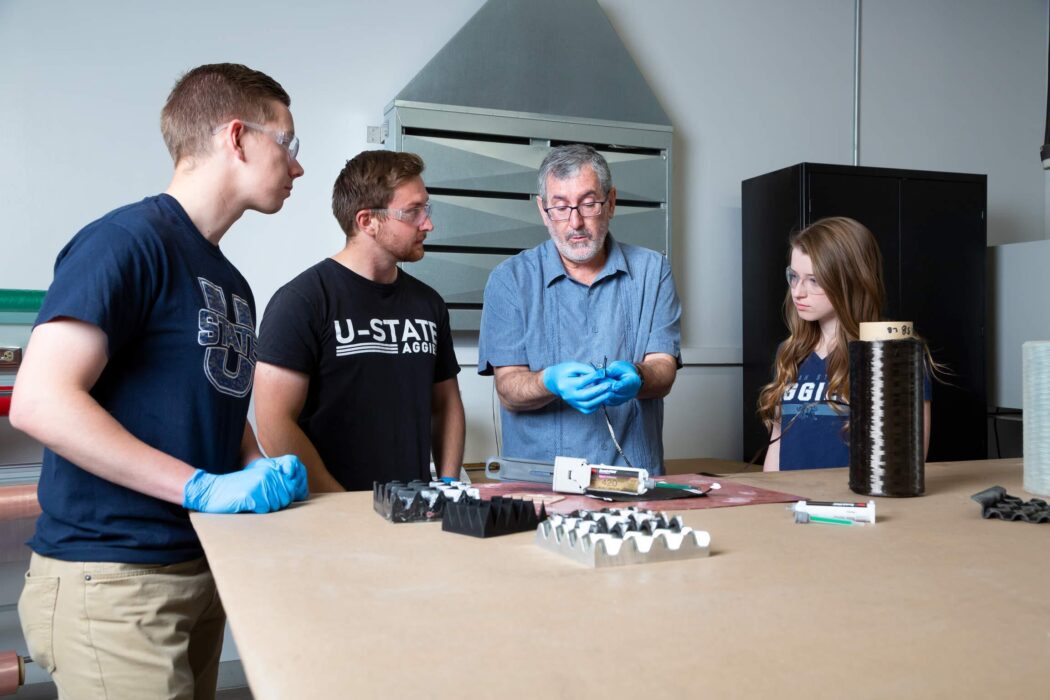The Arrival of a New Center for the Design and Manufacturing of Advanced Materials
On April 19, a symposium will be held on the Logan campus of Utah State University. This symposium will mark the beginning of a new center at USU, the Center for the Design and Manufacturing of Advanced Materials. It will be part of the College of Engineering.
Although the center was opened in 2022, it has only now received all the materials and faculty needed to begin teaching the topic of composite materials. These additions include new manufacturing and testing materials that allow students to both learn about and test composite materials, and help engineering students as they prepare to go into the career field.
This symposium will display this new center to both the wider student population and various companies. The symposium will have 10 invited lecturers who will give presentations on advanced materials, as well as an introduction and explanation of the new center.
Speakers at the symposium will include many in the business and research world from a variety of companies such as Northrop Grumman, Utah Advanced Materials and Manufacturing Initiative (UAMMI) and Hexcel Corporation, as well as schools such as the Miller Advanced Research and Solutions (MARS) center at Weber State University. These presentations will be primarily on the technical side.
Matt Jensen, director of PR and marketing for the College of Engineering, wrote in an email that there will be a Master of Science (MS-Plan C) in Composite Materials and Structures, and a plan for a Professional Certificate in Composites is in the works that will be available by the fall of 2024.
This master’s degree program will also be shared, to both academia and business and industry partners.
A tour of the new labs for composite materials and the equipment there will occur as well.
“We are gaining some fairly unique equipment,” said Dr. Greg Anderson, a professor for the department of Mechanical and Aerospace Engineering, and the new director for the Center for the Design and Manufacturing of Advanced Materials. “One that allows us to measure the adhesion strength of polymer-made material bonded to a single carbon fiber, where that carbon fiber is one tenth of a human hair.”
As for the center itself, it will be part of the Mechanical and Aerospace Engineering department. The center will focus on the designing and manufacturing of composite materials.
“Utah State has historically had some material science courses and some research in advanced materials, but with additional state funding for the center, to increase our teaching capability and our research and testing capability,” Anderson said.
The state funding in question is about $1.2 million, with the funding to focus on two main areas: composite materials, and increased research and teaching of high temperature materials.
High-temperature materials refer to materials that can withstand extreme temperatures, such as 3,000 degrees Fahrenheit. These materials can be used in a variety of fields, such as rocketry or in the nuclear industry.
Composite materials are materials that are polymers embedded in fibers to give them much higher structural capabilities, and they can range from carbon fibers to fiber glasses. Their uses can vary as well, from everyday items such as skis, bikes or shower stalls, all the way up to more complex things like rockets and planes.
“Composite materials are stronger than metals, if you take the strength and divide it by the density,” Anderson said. “They are a fraction of the weight.”
“Designing with composite materials is significantly more complex than designing for metals,” Anderson said.
This is due to the fact that the strength of the material is influenced by how and with what you build the materials.
Five courses will be offered at the center. Two of the courses have been taught for a long time, since the 1980s, and they cover the mechanics of composite materials. Among the new courses is a material science course with a focus on composite materials, the testing of composite materials and the manufacturing of composite materials.
These five core courses will be the focus for the master’s program. There will be three prerequisite courses, all three of which will be mid-level mechanical engineering courses.
These prerequisite courses are necessary, as the five courses will be a mixture of both the theoretical and the practical, where some prior knowledge of the basics of engineering will be of assistance.
There are hopes this center will help draw both new students and state funding to USU, especially for those interested in the topic and the research of the topic.
There have been at least three other centers that have at one point or another been part of the College of Engineering alone. Namely, the Space Dynamics Lab that started as a center within the College of Engineering, the water lab and the fairly recent ASPIRE, or Advancing Sustainability through Powered Infrastructure for Roadway Electrification, center.
All three of these centers found success, as well as prestige, and there are hopes by those within the center that the Center for the Design and Manufacturing of Advanced Materials will in turn find such similar results.

